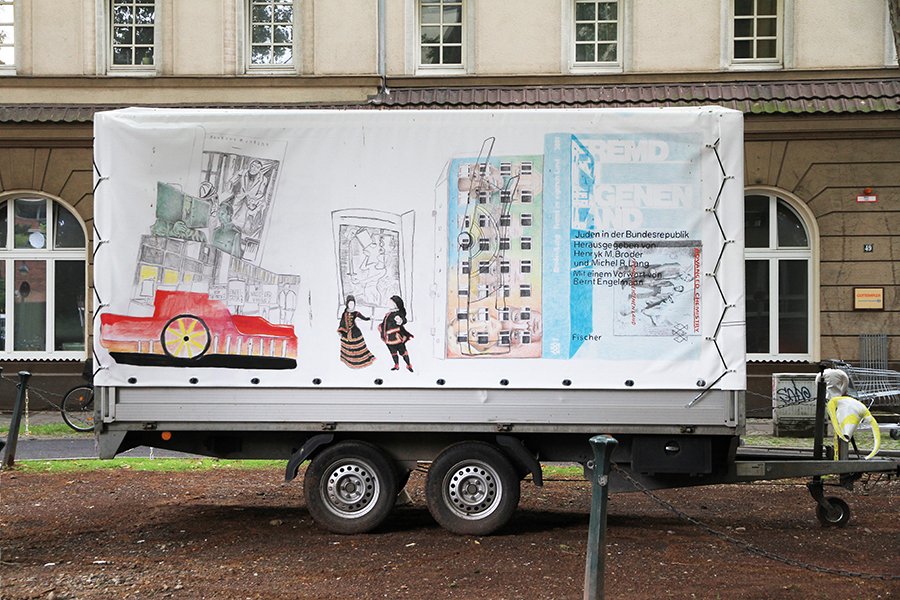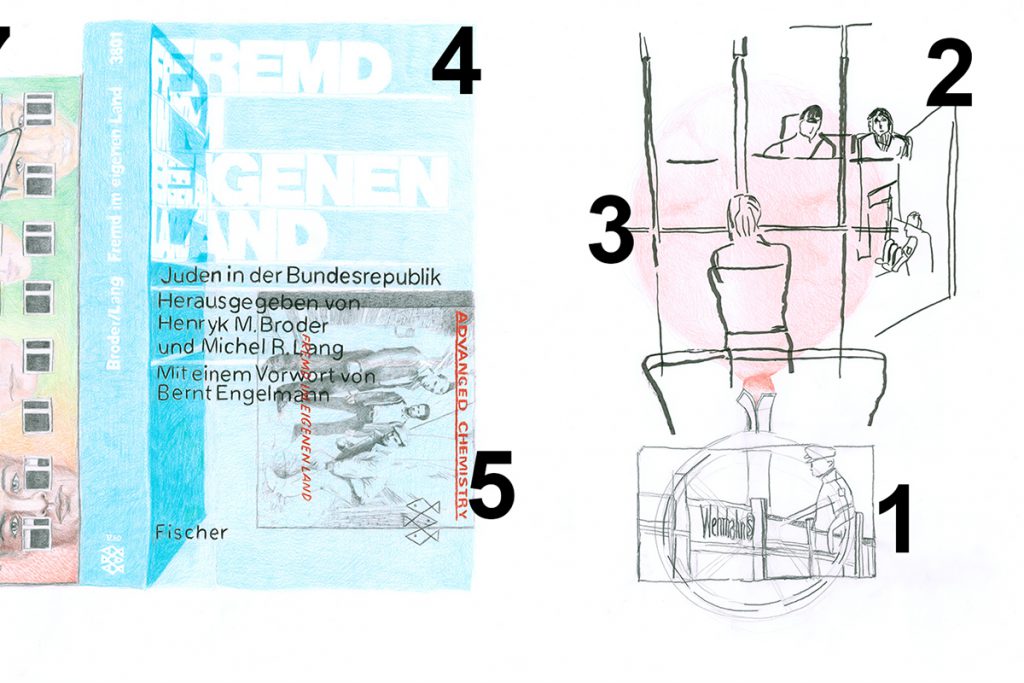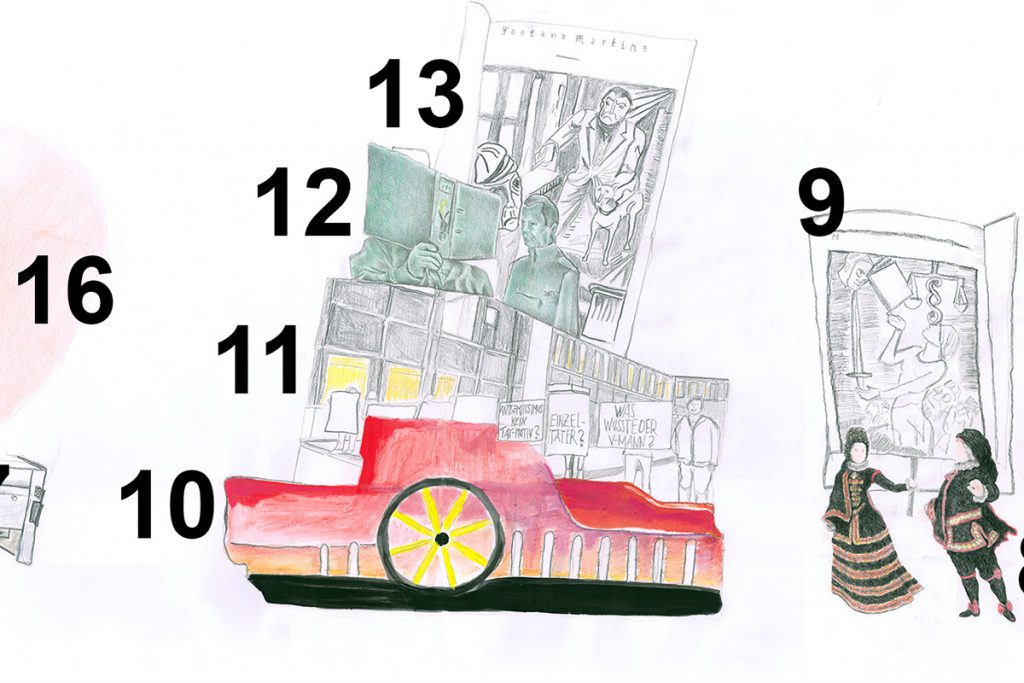Wehrhahn Floats
1 Wehrhahn S-Bahn station. On July 27, 2000, a bomb attack was carried out at the station entrance on Ackerstraße in Düsseldorf. Ten people—all immigrants from Eastern Europe—were critically injured; one woman lost her unborn child. Six of the victims were of Jewish faith. Antisemitic and racist motives were suspected. Even after the 2018 trial, the identity of the perpetrator is still unclear. As of yet there is still no memorial at the site to commemorate the attack.
2 Witness statements at the Wehrhahn trial at the Düsseldorf District Court in 2018. Courtroom observation and sketch. How are right-wing structures articulated in spaces belonging to the legal system?
3 Saubloder (pig’s bladder). In the traditional Alemannic carnival celebrations, a Saubloder is attached to a wooden stick and is struck on the ground during parades (which creates a loud bang), touches the audience. The Saubloder is considered a symbol of carnality, and striking it a symbolic act of fertilization; the “empty vessel” is a symbol of the transience of everything earthly. The empty bladder is also a depiction of the fool himself (the French fou and the English fool are both derived from the Latin follis, meaning an empty bag).
Foreign in One’s Own Country—A Double Float
The float poses critical questions about the attributes “foreign,” “own,” and “countries,” and applies them to right-wing, racist structures as the real outsider within communities that want to live democratically. In doing so, the float incorporates research for a radio program by writer Sammy Khamis from 2018.
4 The spine and cover of Fremd im eigenen Land. Juden in der Bundesrepublik (Foreign in Their Own Country. Jews in the Federal Republic), Fischer Verlag, 1979. In this essay collection, forty authors examine the issue of how they can live as Jews in Germany thirty-five years after the Shoah. One of the editors, Henryk Broder, has been running the journalistic network Die Achse des Guten (The Axis of the Good)—which describes itself as liberal and pro-Western, but has also been perceived as anti-Islamic—together with others since 2004.
5 CD cover for Fremd im eigenen Land (Foreign in One’s Own Country) by Advanced Chemistry, MZEE Records, 1992. Advanced Chemistry was a hip-hop band from Heidelberg founded in 1987 and one of the pioneers of German hip-hop. Released in 1992, their breakthrough single was Fremd im eigenen Land. The song describes the structural racism that migrants encounter in everyday life in Germany.
6 Eine Wand bekommt Gesichter (A Wall Gets Faces). Wall mural design, Klaus Klinger, 2007, Gerresheimer Str. 69, next to the Elisabethkirche and opposite the Wehrhahn S-Bahn station.
7 Echo, Gerd Gebhardt, and Oliver Renelt, 1992. The Echo Awards were a German music prize awarded annually from 1992 to 2018. A debate erupted after the musicians Kollegah and Farid Bang collected the Echo Pop award in 2018 due to antisemitic parts of the musicians’ lyrics, which led to many media outlets, artists, politicians, and sponsors distancing themselves from the Echo Awards; as a result of the criticism, the awards were discontinued.
Procession Attendants
8 Detail from Das Kurfürstenpaar Anna Maria Luise de’ Medici und Johann Wilhelm im spanischen Kostüm beim Maskenball (The Elector Johann Wilhelm and his Wife Anna Maria Luise de’ Medici in Spanish Costume at a Masked Ball), oil painting, Jan Frans van Douven, 1695. Johann Wilhelm von der Pfalz (also known as “Jan Wellem”) and his wife Anna Maria Luise de’ Medici created one of the most significant painting collections in Europe and thus founded the reputation of Düsseldorf as a city of art.
9 Justizia, Fontana Martina, no. 10, woodcut, March 1932
Fontana Martina Float
10 Historical carnival float
11 Antifascist protest at the first day of the hearing of the Wehrhahn trial
12 Detail from a court photo. The accused is hiding his face behind a folder with a hare ears drawn on it.
13 Title page, Fontana Martina, no. 7, woodcut by Clément Moreau, January 1932. The magazine Fontana Martina was published by the artists Fritz Jordi and Heinrich Vogeler in a neighboring town of the artist colony Monte Verita in Tessin from 1931 to 1933. It addressed the burgeoning National Socialist movement and its repressions in Germany from artists’ perspectives.
Intelligence Service Floats
14 Donkey carnival mask. Donkey’s ears were first mentioned as one of the fool’s attributes in 1494 by Stefan Brant in The Ship of Fools.
15 Düsseldorf District Court
16 Saubloder (see above for description)
17 Blacked-out logo of the German intelligence service
18 Car trailer
Security Float
19 Mobile security barrier
20 Stationary security barrier
21 Observation of the trial, witness statements with Google Maps, free drawing
Fools’ Float
22 Fool’s Cap Map of the World, colored copperplate, circa 1600
23 Excerpt from the minutes of the North Rhine-Westphalia Mobile Counsel Against Right-Wing Extremism from March 8, 2018 during the Wehrhahn trial. The main suspect in the trial ran a militaria store opposite the language school. According to witness statements, he stood out in the neighborhood because of his patrol-style circuits of the area with his dog as well as his racist behavior, and he had also been seen repeatedly at the crime scene. According to the minutes, on this day the witness Christine W. (language teacher) spoke of a peaceful empowerment campaign that she carried out with her students from the language school after the group had repeatedly felt threatened by people around the militaria store.
24 Right Terror 2012—Düsseldorf carnival float by Jaques Tilly in 2012 after the NSU revealed themselvesSaubloder (pig’s bladder). In the traditional Alemannic carnival celebrations, a Saubloder is attached to a wooden stick and is struck on the ground during parades (which creates a loud bang), touches the audience. The Saubloder is considered a symbol of carnality, and striking it a symbolic act of fertilization; the “empty vessel” is a symbol of the transience of everything earthly. The empty bladder is also a depiction of the fool himself (the French fou and the English fool are both derived from the Latin follis, meaning an empty bag).
















